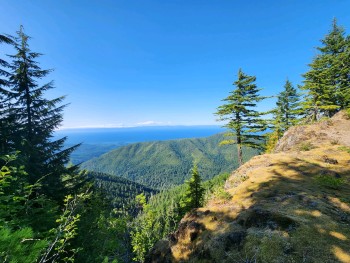About the Area
A bird's eye view from the Pyramid Peak Trail on the Olympic National Forest. USDA Forest Service photo by Megan Berryyoung.
(USDA Forest Service photo by Megan Berryyoung)Perhaps more than any other region in the United States, the Pacific Northwest is defined by its public lands.
More than 30 percent of Washington and 53 percent of Oregon are public lands managed by the federal government. These lands provide the people and communities within Oregon and Washington their livelihood, recreation, visual backdrop, and identity.
The Pacific Northwest Region hosts a variety of ecosystems and ecoregions from wet temperate rain forests in some coastal areas to the more arid high desert areas of eastern Oregon and Washington.
The region is bound by the Pacific Ocean to the west and includes several mountain ranges: the Coast Mountains, the Cascade Range, the Olympic Mountains, and the Columbia Mountains. Active volcanoes within the Oregon and Washington region include Mount Baker, Mount Rainier, Mount St Helens, which erupted in 1980, Mount Hood, and Mount Jefferson. Most of the human population of the Pacific Northwest is currently concentrated in the Vancouver–Seattle–Portland corridor.
Total Forest Acres: 24.9 million
- Oregon Acres: 15.6 million
- Washington Acres: 9.2 million
Region at a Glance
- National Forests: 16
- Ranger Districts: 67
- Directors Areas: 10
Other Designated Areas
- National Scenic Areas: 2
- Natural Scenic Research Area: 1
- National Grasslands: 1
- National Recreation Areas: 4
- National Volcanic Monuments: 2
- National Scenic Trails: 2
Wilderness Areas: 65
- Wilderness Acres: 4,986,459
Wild and Scenic Rivers: 51
- Wild and Scenic River Miles: 1,321
Federally Recognized Tribes: 42
Timber Output
- Timber Volume Sold (Fiscal Year 2024): 594 Million Board Feet
Fire and Fuels
- Acres Burned (Fiscal Year 2024): 519,336
- 10-year Average (Fiscal Year 2024) Acres Burned: 477,525
- Prescribed Fire Acres (Fiscal Year 2024): 119,708
- Mechanical Acres - thinning etc. (Fiscal Year 2024): 287,144
Recreation
- Public Visits (Fiscal Year 2023): 18,363,800
- Campgrounds: 923
- Day-Use Sites: 194
- Miles of Trails: 25,860
Fish and Wildlife
- Wildlife Species (birds, amphibians, reptiles, mammals): 627
- Fresh Water Fish Species: 125
- Fish bearing streams: 25,200 miles (approx.)
- Endangered Species (plants, animals): 39
- Regional Forester’s Sensitive Species List: (plants, animals, fungi): 1,053
Pacific Northwest Region
Upper Crooked River flowing through Ochoco National Forest.
(USDA Forest Service.)The Forest Services manages over 24 million acres of National Forest lands in Oregon and Washington, accounting for 25% of all lands in Oregon and 15% of all lands in Washington. The Pacific Northwest Region offers more than 24,000 miles of trails, 51 Wild and Scenic Rivers, two National Monuments, and over 3,000 outdoor recreation areas, facilities, and programs.
The Pacific Northwest includes the rugged Pacific Coast, temperate Coastal Mountain rainforests, green river valleys, volcanic snow-capped mountains, and an expansive, arid high desert.
The region is characterized by an abundance of mountain ranges, including the Coast Mountains, the Cascades Range, and the Blue Mountains. Most of the National Forests in the region encompass these mountains, providing resources for nearby communities. Fifty seven mountains rise above 8,000 feet in elevation.
Almost every river, stream, and tributary in the Pacific Northwest drains into the Columbia River, save for the few that empty into the Pacific Ocean, Puget Sound, or Fraser River in Canada. These waters provide habitat for native fish, water for nearby communities, and world-class recreation for visitors. Rivers in the Pacific Northwest contain several species of salmon: Chinook, coho, sockeye, chum, and pink, along with two species of sea-run trout (steelhead and coastal cutthroat).
CASCADE MOUNTAINS
The dramatic snow-capped Cascade Range runs north and south extending from northern California to central British Columbia. Much of the southern range is volcanic in origin. The northern portion of the range is increasingly rugged and more influenced by glaciation. The upper mountain elevations receive the highest amount of snow in the continental United States. The west side is wetter from the moisture-laden air streaming from the Pacific Ocean. The warmer, drier east-slope includes high-desert vegetation such as ponderosa pine, red fir, and lodgepole pine.
COASTAL RANGE
The Coastal Range consists of relatively low, steep mountains running parallel to the coastline. The mountains receive high rainfall, which supports moist forests of western hemlock. Along the coast, fog drip is also a factor. Here the forests are characterized by Sitka spruce. Extensive logging influenced this landscape too. Management of threatened, endangered, and special status species, e.g.; northern spotted owl, and marbled murrelet remain a high priority for today’s managers.
BLUE MOUNTAINS
This area is marked by wide, uplifted plateau, dissected by landslide and fluvial processes. Mesas and buttes are common. Vegetation patterns are complex with grand fir/Douglas-fir forests, followed by ponderosa pine, lodgepole pine, and western juniper. Fire, and insect outbreaks are major concerns for land management.
COLUMBIA RIVER GORGE
Dramatic basalt headwalls, a vast river, cascading waterfalls, roaring winds, and spectacular vistas part the Cascade Mountains at the doorstep of the Portland/Vancouver metropolitan area. climate is dry to the east with sagebrush steppe vegetation and moisture-laden to the west with Douglas fir forests.
HIGH DESERT
The High Desert extends from the Cascades to the Rockies. The climate is dry, with sagebrush steppe as the characteristic vegetation, but also includes fescue grasses. Dry-land and irrigation agriculture dominate.





